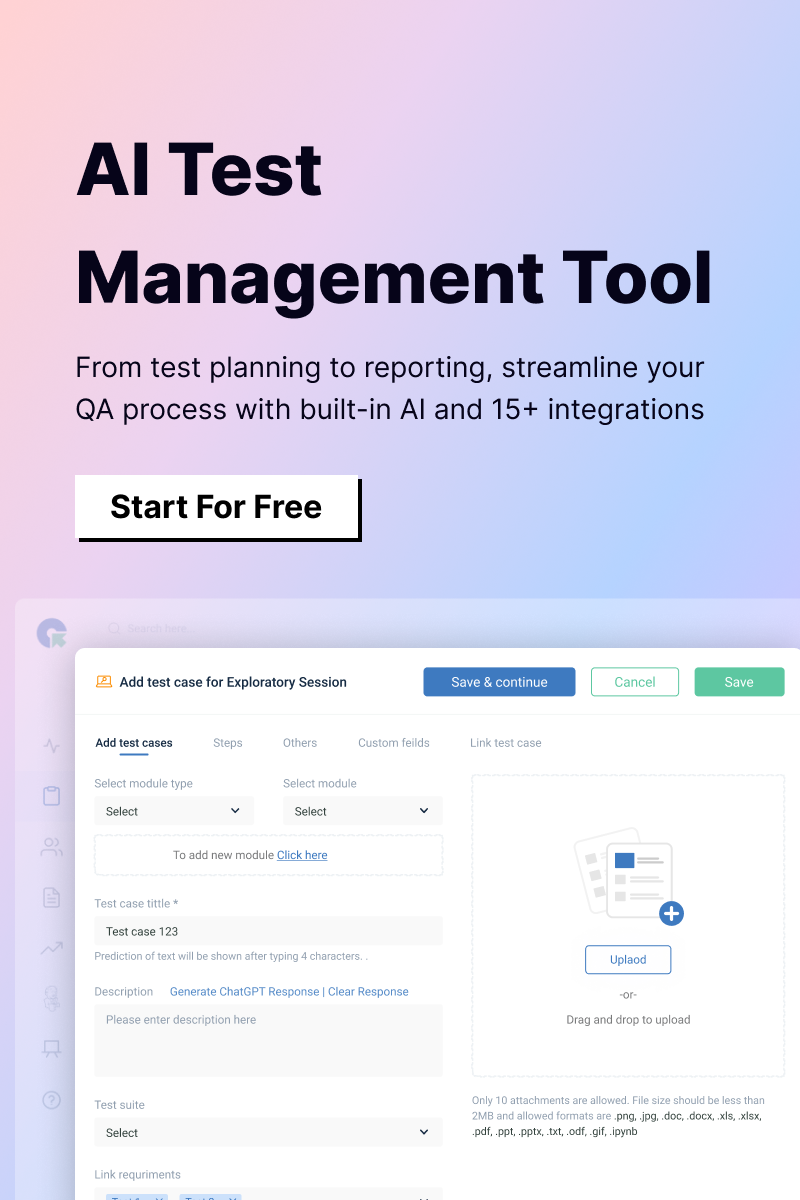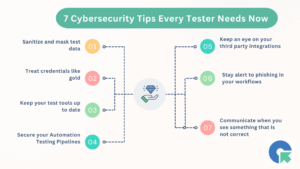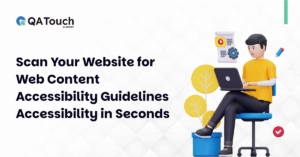Visual UI Testing is a quality assurance practice that ensures a user interface appears correctly across different browsers, devices, and screen resolutions. While functional testing checks whether the UI behaves as expected, visual testing verifies how the interface looks, thus identifying layout issues, misaligned elements, broken styles, or visual regressions that could impact user experience. In this blog, we will learn about Visual UI Testing, how it works, how it compares to functional UI testing, and how to implement it effectively using modern tools and automation. Read along to find out more.
What is Visual UI Testing?
Visual UI Testing is a method of comparing the rendered UI of an application against an expected design or baseline image. It captures screenshots of web or mobile pages and automatically compares them with previously approved versions.
This approach detects inconsistencies in:
- Layout and positioning of elements
- Font types, sizes, and colors
- Image rendering and scaling
- Button alignment and styling
- Responsive behavior across viewports
- Browser-specific rendering differences
The objective is to maintain visual consistency across all versions of the application.
Why is Visual UI Testing Important?
Maintaining the visual integrity of an application’s user interface is just as critical as ensuring its functionality. Below are the main reasons why visual testing should be a standard part of any testing strategy.
- End-user Experience: UI is often the first interaction users have with an application. Visual defects can lead to poor user experience and lost engagement.
- Cross-Browser Consistency: Different browsers may render UI elements differently. Visual UI testing ensures that the design looks consistent across all browsers, such as Chrome, Firefox, Safari, and Edge.
- Responsive Design: Ensures that the UI is adaptive and user-friendly across various screen sizes (mobile, tablet, desktop).
- Faster Bug Detection: Automated visual tests help catch UI regressions earlier in the development process, saving time compared to manual testing.
- Reducing Human Error: Visual UI testing minimizes the risk of human error that occurs during manual verification, especially in large applications with numerous UI components.
How is Visual UI Testing Different from Functional UI Testing?
While both Visual UI Testing and Functional UI Testing are critical to ensuring the quality of a user interface, they serve very different purposes. Understanding the distinction between these two testing types can help you implement a balanced testing strategy.
Functional UI Testing
Functional UI Testing is focused on verifying the behavior and interactions of user interface elements. It checks whether the components of the UI function as expected from a user perspective.
Key Characteristics:
- Interaction Testing: Ensures that buttons, forms, dropdowns, and other components respond correctly to user inputs.
- Flow Validation: Confirms that user flows (such as logging in, submitting a form, or completing a transaction) behave as designed.
- Event Handling: Tests whether specific events (like clicks, hovers, or form submissions) trigger the appropriate actions.
- Tools: Uses automation frameworks like Selenium WebDriver, Cypress, and TestCafe to simulate real user interactions and validate UI functionality.
For example, a functional test would verify that clicking a “Login” button submits the login form and redirects the user to the dashboard. It does not check whether the button is correctly aligned or if the color matches the brand guidelines.
Visual UI Testing
Visual UI Testing focuses on the appearance and layout of UI components rather than their behavior. It ensures that the visual presentation of the interface remains consistent and aligned with design expectations.
Key Characteristics:
- Pixel-Level Validation: Compares rendered UI against a visual baseline to detect layout shifts, font issues, misaligned elements, and broken styles.
- Design Consistency: Ensures that visual elements like colors, typography, spacing, and icons appear uniformly across all browsers and devices.
- Cross-Device Assurance: Validates UI rendering on various screen sizes and resolutions to maintain a responsive experience.
- Tools: Common tools include Applitools Eyes, Percy by BrowserStack, and BackstopJS, which automatically capture screenshots and perform visual diff comparisons.
A visual test would detect if a “Login” button is one pixel off-center, if a form field overlaps with a label, or if a new stylesheet caused a font change—issues that functional tests would not catch.
Key Differences Between Functional and Visual UI Testing
| Aspect | Functional UI Testing | Visual UI Testing |
| Focus | Validates the behavior of UI elements (e.g., click, submit) | Validates the appearance of UI elements (e.g., layout, styles) |
| Purpose | Ensures the system works as intended | Ensures the interface looks as intended |
| Tools | Selenium, Cypress, TestCafe | Applitools Eyes, Percy, BackstopJS, Webdriverio, PhantomCSS, Appium, Jest, Selenium, etc. |
| Test Type | Interaction-based testing (event handling, input validation) | Pixel-based testing (design consistency, layout accuracy) |
| Use Case | Verify that users can complete workflows and interactions | Detect visual regressions or inconsistencies post-deployment |
How Does Visual UI Testing Work?
Visual UI Testing relies on automation to detect unintended changes in an application’s appearance by comparing how the UI renders across versions, environments, or devices. The goal is to ensure that any visual updates are intentional and align with design specifications. Here’s a step-by-step look at how this process typically works:
1. Capturing Baseline Screenshots
The first step in visual testing is establishing a baseline, which serves as the visual reference point.
- When a test runs for the first time, the tool captures a high-resolution screenshot of the application or component in its expected visual state.
- This baseline image represents the “approved” version of the UI against which future tests will be compared.
- It can include full-page views or specific sections of the UI such as headers, forms, or modals.
Example: A baseline screenshot might capture the login screen of a web app, showing a centered form, correctly colored buttons, and brand-aligned typography.
2. Comparing Screenshots in Subsequent Tests
Once the baseline is established, each new test execution involves capturing and comparing a current screenshot against the baseline image.
- The tool performs a pixel-by-pixel comparison to identify any differences between the two versions.
- Even the smallest changes, such as a 1-pixel shift in a button, a color shade mismatch, or a change in spacing, can be detected.
- Some tools use AI algorithms to filter out unimportant changes (like anti-aliasing differences or sub-pixel shifts) to reduce noise in results.
For example, if a developer unintentionally changes a global font size or updates CSS that alters a layout, the visual test will flag this as a regression.
3. Reporting & Debugging UI Differences
The tool highlights the affected areas and generates a detailed report when differences are found during the comparison step.
- The test is marked as failed if the detected changes exceed a predefined threshold.
- Visual diffs are displayed, usually in three panels: baseline image, current image, and a diff image highlighting differences.
- Testers and developers can then decide whether the change was intentional (e.g., part of a redesign) or a defect introduced by mistake.
- Based on this review, they can either update the baseline to reflect approved changes or create a ticket to resolve the issue.
This review process helps ensure that only approved visual updates are pushed forward in the release pipeline.
Types of Visual UI Testing
Visual UI Testing can be implemented in several ways depending on the goals, project stage, and available tools. Each type plays a unique role in maintaining the visual consistency and design quality of user interfaces. Below are the key types of visual testing used in software development workflows.
Manual Visual Testing
Manual Visual Testing involves testers manually reviewing the UI to ensure that elements like layout, colors, fonts, and images appear as expected. This method is useful for early-stage design checks or small projects but can be slow and error-prone, especially in large or complex applications.
Automated Visual Testing
Automated Visual Testing relies on tools that capture screenshots of the UI and compare them to baseline images. These tools highlight any visual differences, allowing teams to catch regressions quickly. This method is faster, more accurate, and scales well across large projects with frequent design updates.
Responsive Design Testing
Responsive Design Testing focuses on how well the UI adapts to different screen sizes and devices. It helps ensure that users have a seamless experience whether they’re on a smartphone, tablet, or desktop. Tools can simulate multiple viewports to test layouts without the need for physical devices.
Cross-Browser UI Testing
Cross-Browser UI Testing checks how the UI renders in different web browsers such as Chrome, Firefox, Safari, and Edge. Since each browser may interpret styles slightly differently, this testing helps ensure the interface remains visually consistent regardless of the browser being used.
Example: Automating Visual UI Testing with Selenium & Applitools
Here’s a basic example using Selenium WebDriver and Applitools Eyes in Python:
Step 1: Install Dependencies
pip install eyes-selenium
Step 2: Write the Test Script
from selenium import webdriver
from applitools.selenium import Eyes
# Set up WebDriver
driver = webdriver.Chrome(executable_path=’/path/to/chromedriver’)
# Initialize Applitools Eyes
eyes = Eyes()
eyes.api_key = “YOUR_API_KEY”
try:
# Start the test
eyes.open(driver, “Demo App”, “Visual UI Test”, {“width”: 1024, “height”: 768})
# Navigate to page
driver.get(“https://example.com”)
# Take a screenshot for visual validation
eyes.check_window(“Homepage Screenshot”)
# End the test
eyes.close()
finally:
driver.quit()
eyes.abort_if_not_closed()
This test captures a screenshot of the homepage and compares it with the baseline. Any unexpected visual change will trigger a test failure.
Popular Visual UI Testing Tools
Here, have a look at the top tools for visual testing:
| Tool | Features | Best For |
| Applitools Eyes | AI-powered visual testing | Cross-browser testing |
| Percy by BrowserStack | Automated screenshot comparison | CI/CD integration |
| Visual Regression Tracker | Open-source visual testing | Teams with custom setups |
| Chromatic | UI component testing for React | Storybook integration |
Challenges in Visual UI Testing
While Visual UI Testing is an invaluable tool for maintaining the quality and consistency of an application’s design, it does come with its set of challenges. Here, have a look:
1. Handling Dynamic Content
Dynamic content such as advertisements, timestamps, or animations can cause false positives in visual tests. Since these elements change or update frequently, they can lead to discrepancies between the baseline image and the current test, even though they do not impact the overall design.
To mitigate this, you can use tools to ignore dynamic sections of the UI during visual comparison. Techniques like fuzzy matching or element exclusion can be employed to filter out these dynamic areas, ensuring that the test focuses only on the static elements that should remain consistent.
2. False Positives in Visual Tests
Minor, unintentional changes in the UI, such as a slight shift in the position of a button or a small pixel-level variation, can trigger false positives. These insignificant changes may not actually affect the user experience but still cause the test to fail.
To address this, you can set tolerance thresholds in visual testing tools. These thresholds define an acceptable level of variation, allowing minor differences (e.g., a 1-pixel shift) without causing a test failure. This way, only significant changes that affect the design are flagged as issues.
3. Managing UI Variations Across Devices
UI elements may appear differently across various screen sizes, devices, and resolutions. For example, a layout might look perfect on a large desktop monitor but have alignment issues on a smaller mobile screen. This variability can make it challenging to maintain visual consistency.
Implementing responsive design testing is key to ensuring UI consistency across devices. Some tools can simulate different screen sizes and orientations, allowing you to check how the UI adapts. By testing on multiple devices and resolutions, you can ensure the design remains user-friendly and visually consistent with the platform.
Integrating Visual UI Testing in CI/CD Pipelines
Automating visual tests in your CI/CD pipeline ensures continuous feedback on design changes. Here’s how to do so:
1. Running Visual Tests in CI/CD (Jenkins Example)
One of the best ways to incorporate visual testing into your CI/CD pipeline is by using Jenkins, a popular automation tool. By integrating Applitools Eyes or similar visual testing tools into Jenkins, you can run automated visual tests on every build, ensuring your UI remains consistent after every change.
Here’s an example of how to add visual testing to your Jenkins pipeline:
Jenkinsfile Example:
pipeline {
agent any
stages {
stage(‘Build’) {
steps {
echo ‘Building Application…’
}
}
stage(‘Visual UI Testing’) {
steps {
// Run visual tests using pytest
sh ‘pytest test_visual.py’
}
}
}
}
2. Automating UI Snapshots for Every Deployment
To maintain visual consistency across all releases, it’s important to automate the capture of UI snapshots with every deployment. By doing this, you create a baseline image of the UI that serves as a reference point for all future tests.
Automating UI snapshots provides several benefits:
- Visual Consistency: Ensures that every release maintains the same visual quality.
- Regression Prevention: Catches visual regressions before deployment, making sure that any unintended UI changes are flagged before reaching production.
- Efficiency: By automating the process, you eliminate the need for manual visual checks, allowing you to focus on other critical areas of development.
Best Practices for Visual UI Testing
Following some best practices is essential to ensuring your Visual UI Testing process is efficient, accurate, and scalable.
1. Use AI-Powered Tools
AI-powered tools like Applitools Eyes are great at cutting down false positives. They help detect real visual issues while ignoring small, insignificant changes, so you can focus on what truly matters.
2. Define Tolerance Levels
Setting tolerance levels helps avoid unnecessary test failures from tiny UI shifts. Letting small variations slide like a pixel shift or dynamic content keeps your tests focused on meaningful differences, not on minor, non-impactful changes.
3. Test Across Multiple Viewports
It’s important to test how your UI looks on different devices and screen sizes. Tools like BrowserStack make it easy to ensure your design adapts to everything from mobile phones to desktops, making sure your app looks great everywhere.
4. Automate Visual Testing in CI/CD
By adding visual testing to your CI/CD pipeline, tools like Applitools Eyes or Percy can automatically check for visual issues each time you deploy. This helps catch any design inconsistencies early, so your app is ready to go without any visual surprises.
Real-World Use Cases for Visual UI Testing
| Industry | Why Visual UI Testing is Important |
| E-Commerce | Ensures product images, buttons, and checkout flow are consistent across all devices, improving conversions and user trust. |
| Banking & Finance | Prevents broken UI in critical workflows like payments, ensuring a smooth and secure user experience in financial transactions. |
| Healthcare | Ensures accurate rendering of medical forms and reports, preventing confusion and errors in patient care or data interpretation. |
| Gaming & Entertainment | Validates consistent UI experience across devices, ensuring an engaging and seamless experience for users, whether on mobile or console. |
Conclusion
Visual UI testing is critical in delivering high-quality applications with flawless user interfaces. By catching visual bugs early in the development process and ensuring consistency across devices and browsers, visual UI testing helps maintain the user experience and brand integrity. Automated tools have significantly enhanced the process, making it easier and more efficient than ever before.
If you’re building or testing a user-facing application, incorporating visual UI testing into your workflow is an essential step to ensuring that your UI not only works as intended but also looks great across all devices.
QA Touch is an all-in-one test management platform that helps you manage all your testing needs, from planning to execution and defect tracking, from a single platform.
Sign up today to start using the platform instantly. It’s free till you upgrade.










